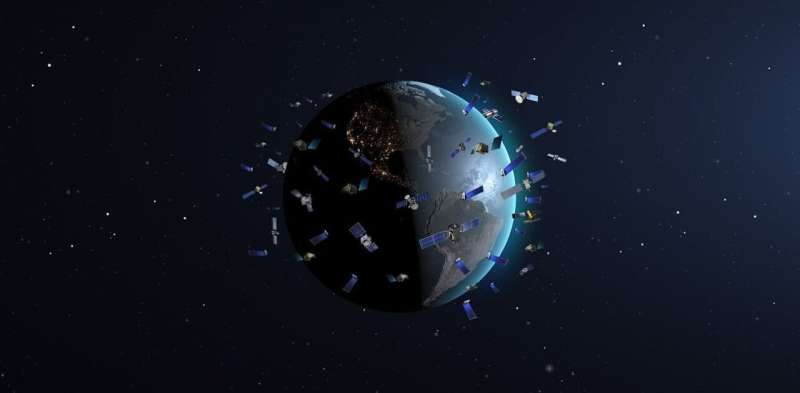
Most space mission systems historically have used one spacecraft designed to complete an entire mission independently. Whether it was a weather satellite or a human-crewed module like Apollo, nearly every spacecraft was deployed and performed its one-off mission completely on its own.
But today, space industry organizations are exploring missions with many satellites working together. For example, SpaceX’s Starlink constellations include thousands of satellites. And new spacecraft could soon have the capability to link up or engage with other satellites in orbit for repairs or refueling.
Some of these spacecraft are already operating and serving customers, such as Northrop Grumman’s mission extension vehicle. This orbiting craft has extended the lives of multiple communications satellites.
These new design options and in-orbit capabilities make space missions look more like large logistics operations on Earth.
We’re researchers who have studied the space industry for years. We’ve studied how the space sector could learn lessons from companies like Amazon or FedEx about managing complex fleets and coordinating operations.
Lessons from the ground transportation network
Space mission designers plan their routes in order to deliver their payloads to the moon or Mars, or orbit efficiently within a set of cost, timeline and capacity constraints. But when they need to coordinate multiple space vehicles working together, route planning can get complicated.
Logistics companies on the ground solve similar problems every day and transport goods and commodities across the globe. So, researchers can study how these companies manage their logistics to help space companies and agencies figure out how to successfully plan their mission operations.
One NASA-funded study in the early 2000s had an idea for simulating space logistics operations. These researchers viewed orbits or planets as cities and the trajectories connecting them as routes. They also viewed the payload, consumables, fuel and other items to transport as commodities.
This approach helped them reframe the space mission problem as a commodity flow problem—a type of question that ground logistics companies work on all the time.
Lessons from ground logistics infrastructure
New capabilities for refueling and repairing spacecraft in orbit create new opportunities as well as challenges.
Namely, space operators don’t usually know which satellite will be the next one to fail or when that will happen. For these new technologies to be useful, space mission designers would need to come up with an infrastructure system. That could look like a fleet of service vehicles and depots in space that quickly respond to any unpredictable events.
Fortunately, space mission designers can learn from operations on the ground. City planners and emergency response organizations think through these types of challenges while determining where to locate hospitals or fire departments. They also consider these facilities’ capacities to respond to unpredictable calls.
We can draw an analogy between a ground logistics system design and an in-space servicing system design. This way, researchers can leverage theories developed for ground logistics to improve the space mission design practice.
One study published in November 2020 developed a framework for servicing spacecraft on orbit using what logistics experts call spatial queuing theory. Researchers most commonly use this modeling theory to analyze the performance of a ground logistics system.
Lessons from ground warehouse management
In the past, individual spacecraft carried out their missions independently, so if a satellite failed, its mission engineers had to develop and send a replacement.
Now, for missions with multiple satellites, such as the Iridium satellite constellation, operators often maintain one or more spares on orbit.
This becomes complicated for constellations made up of hundreds or thousands of spacecraft. Mission designers want to ensure they have enough spare satellites in orbit so they don’t have to interrupt the mission if one breaks. But sending too many spare satellites gets expensive.
When dealing with these types of large constellations, mission designers can learn from the methods Amazon and other ground companies use to manage their warehouses. Amazon puts these warehouses in specific places and stocks them with certain items to make sure the deliveries are handled efficiently.
Inventory management theories on the ground can help inform how space companies tackle these challenges.
A study published in November 2019 developed an approach that space companies could use to manage their spare strategies. This approach can help them decide where in orbit to allocate their spare satellites to meet their needs while minimizing any service interruptions.
International dimensions
Spacecraft operate in a complex and rapidly changing environment. Operators need to know where other missions are operating and what rules they should follow when refueling or repairing in space. In space, however, nobody has defined these rules yet.
Ships, aircraft and ground vehicles all have clear rules of the road to follow when interacting with other vehicles. For example, civilian ships and aircraft have to share their location with other vehicles and officials to help manage traffic.
Some researchers are examining what similar rules could look like for space. One study examined how developing rules based on a spacecraft’s size, age or other attributes might help future space operations run more smoothly. For example, one rule might be that the spacecraft that launched most recently should take responsibility for maneuvering when there’s another craft in its path.
With more satellites and spacecraft launching now than ever, companies and government agencies will need new technologies and policies to coordinate them. As space activity becomes more complex, researchers can continue to apply what they’ve learned on the ground to new missions in space.
Provided by
The Conversation
This article is republished from The Conversation under a Creative Commons license. Read the original article.
Lessons from industry can inform satellite and spacecraft management in orbit (2024, August 22)
retrieved 22 August 2024
from https://phys.org/news/2024-08-lessons-industry-satellite-spacecraft-orbit.html
part may be reproduced without the written permission. The content is provided for information purposes only.